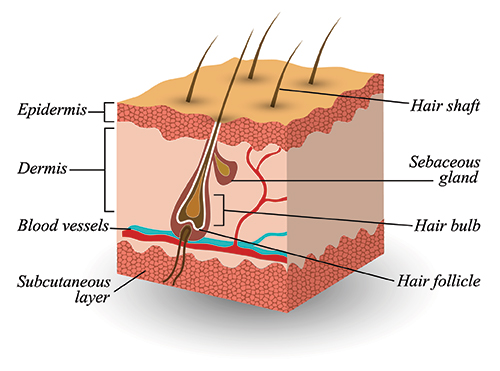Hair is made up of a very simple structure. Protein and keratin. Keratin forms the strength of our hair, nails, and the outer layer of our skin. Keratin is a large molecule that is made up of smaller units, these are called amino acids and they join together to form a chain.
Our hair is made up of different layers and structures, where they can result in different way and therefore we have three main types of hairs on our body. Vellus hairs (very thin hair), Androgenetic (Body hair),Terminal hairs and Intermediate hairs. Our body contains detailed and structured hair follicles and hair shafts, which arise from an indentation on the epidermis (the skin).

Hair Follicle (part from which the hair grows):
- The end part of hair follicle is called hair bulb
- The structure of hair bulb is formed by actively growing cells, which produce the long, fine and cylindrically-shaped hair fibres
- The hair bulb has special cells (melanocytes) which produce the pigment that gives hair its colour. That pigment is called melanin
- Androgens (male hormone receptors) are located on the cells of this structure
- Dermal papilla that feeds from the bloodstream and provides nourishment to create new hair and is located at the base of hair follicles
- Internal and external root sheaths cover the hair follicles within the skin
- The outer rooting of a hair follicle has a continuous growth cycle along with the epidermis
- The most important one of these glands is the sebaceous gland, as it produces and secretes the natural oils which lubricate the hair
Hair Shaft (part seen above the skin):
- The hair shaft is made up of dead cells that have turned into keratin and binding material, together with small amounts of water. Therefore we don`t feel any pain during haircut
- The hair shaft is formed out of three layers
- Medulla: core of the hair shaft
- Cortex: middle layer of hair shaft providing texture, colour and strength of hair fibre
- Cuticle: outer layer of the hair shaft serving as a protection to the cortex
Hair growth cycle consists of three phases:
- ANAGEN (growing) PHASE is the longest and constitutes about 90% of the growth cycle. This phase lasts 3 to 5 years.
- CATAGEN (intermediate) PHASE where hair follicles prepare themselves for resting phase. This phase lasts around 1 to 2 weeks, while during this phase hair follicles start to collapse.
- TELOGEN (resting or shedding) PHASE usually lasts 3 to 4 months. At the end of this period older hairs that have finished their life cycle falling out and they are replaced by newer hair.
Genetics has strong influence and determine hair follicles’ pattern of growth and rest. With aging hair follicles are programmed to stop producing hair and spend more time in the resting stage. Leading a healthy lifestyle and reducing stress can help to prolong your hair growth cycle. As all hairs are shed at the end of their growth cycle, some degree of hair loss is accepted as normal in every individual. If your hair growth cycle does not recover and you have noticed receding hairline for period time over a year? It`s most probably genetic and you have inherited the trait. Before you make any decisions, it is important to understand your type of hair loss at a consultation. We are here to help you understand your hair loss.
